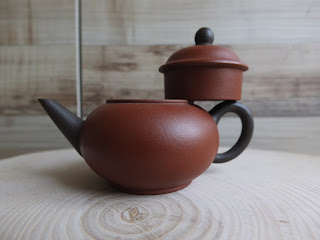This teapot is called "Tao Se shui ping hu". 'Tao Se' literally means colourful teapot, while 'shui ping hu' refers to the classical design of this teapot.
Colourful teapot here meant that 2 different clays were used in the production of the teapot. You will notice the red clay used for the body while a greenish clay for the spout, teapot cover nob and the handle of the teapot. 'Colourful' teapots was quite popular for a period in the 80s. One of the teapots in the last pix is a duan ni (yellow clay) and green clay combination.
You would had noticed that the teapot lid wall literally stands out. Known as 'gai chiang' (lid wall), the wall is noticeably longer or higher than modern Chinese teapots. This 'high wall' has an advantage in that when you pour tea from the teapot, you can actually tilt the teapot at a more forward angle without worrying the lid falling off as the 'high wall' would be working to keep the teapot cover on.
The disadvantage of this 'high wall' is that it will displace some tea when the lid is on. For this small teapot, the displacement is significant. Let me explain, I could fill about 75ml of tea to the brim of this teapot, but once the lid is on, only 60ml of tea can be retained in the teapot. For Chinese teapot collectors, Chinese teapot capacity is measured with the lid on.
A fun teapot to use. Makes great tea as well.




No comments:
Post a Comment